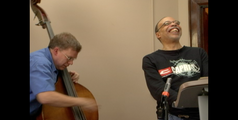The Control of Acoustic Intensity During Jazz and Free Improvisation Performance: Possible Transcultural Implications for Social Discourse and Community
Freya Bailes, Roger Dean
Published: 2010-12-06
This paper demonstrates the predominance of a pattern of acoustic intensity change in recorded improvisations. A wide range of Western music is studied, and the analyses are conducted by measuring intensity in moving windows across each piece. The recurrent pattern is interpreted in terms of a hypothesised Force-Effort-Energy-Loudness-Affect chain, linking performer (or composer) with listeners and with other performers. It seems that improvisers share a patterning of acoustic intensity with interpreters of classical music, and composers of electroacoustic music. Thus, this article suggests that music made without acoustic instruments, that is without the physical intervention of performers providing the energy to activate a sounding instrument, has developed the same pattern because composers recognise its expressive power as a statistical archetype. It remains to be seen whether this statistical feature could have been assimilated from environmental and/or speech sounds.
Available Files
-
Possible_Transcultural_Implications_for_Social_Discourse_and_Community.pdf
Download


